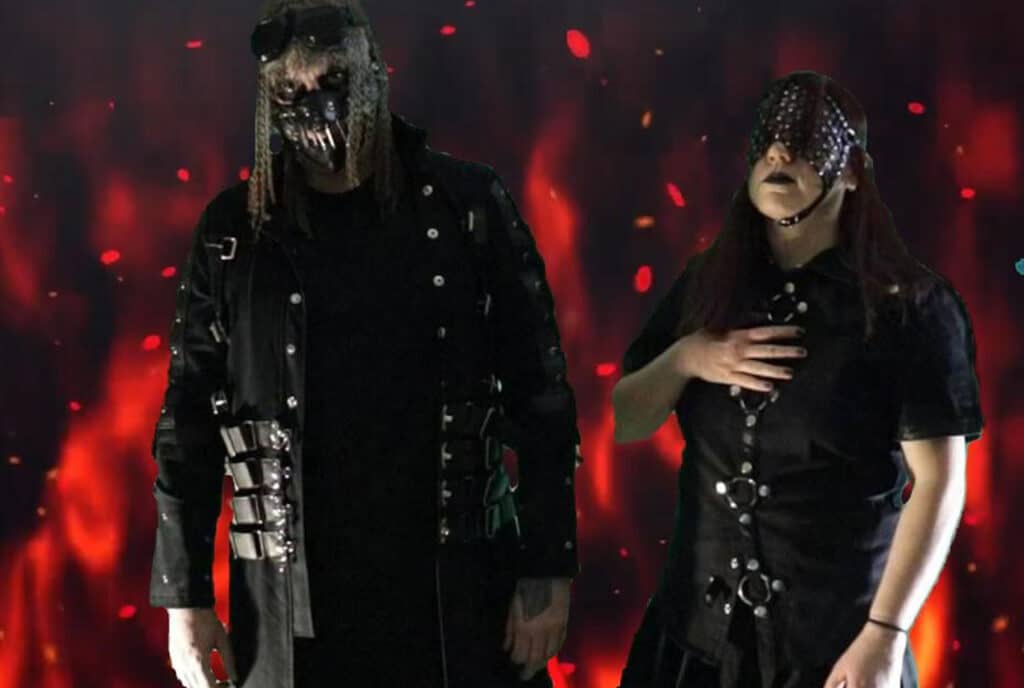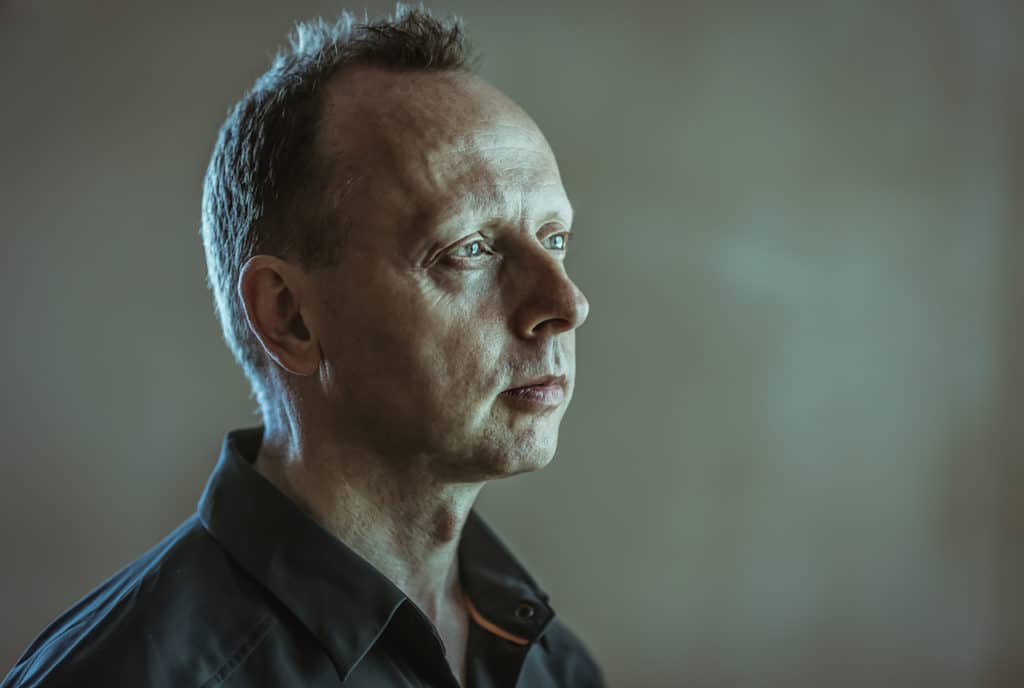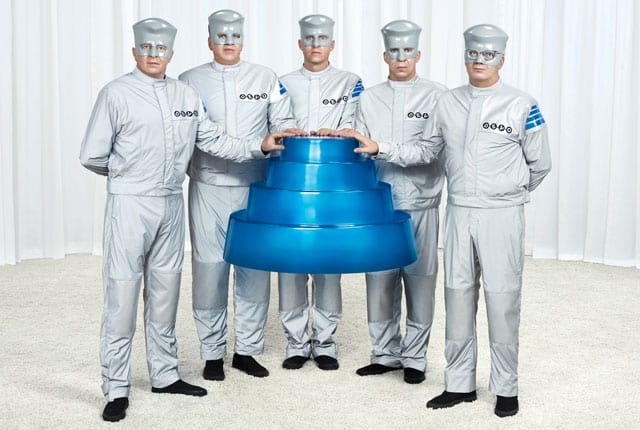Outside of his work as MC/vocalist in The Prodigy, Maxim is an acclaimed mixed-media artist. He’s recently launched Hope, a collaboration with Dan Pearce that has allowed him to combine his creative skills. It’s a series of sculptures, a film, and a music EP (initially only available with the sculptures). There is also an NFT component and exhibit in London’s 99 Projects gallery. Hope was born out of the pandemic and based on the image of Pearce’s son wearing a gas mask and preparing to pull the pin of a clear grenade that contains a heart. Several of the sculptures were donated to raise money for charities. In the following interview, Maxim discusses the motivations and process behind the project.
How did the Hope project come together?
Dan Pearce came up to me and said, ‘Oh, it’d be good to do a collaboration.’ I’ve known Dan for quite a few years, so I said, ‘Yeah, cool. Let’s collaborate.’ But what’s at the basis of the project is a grenade. I had an idea of the grenade probably about a year before that. I was just in the process of getting it made as an actual sculpture, like a clear grenade with a heart inside it. So obviously, the thing behind a grenade is that it brings destruction; you throw it in the direction of something you want to kill, something you want to maim, or so on. And I thought, how about putting a heart inside it, and when you throw it, it spreads love? So that’s the foundation of the whole of the film.
So I said, ‘You know what? I’ve got a sculpture of a grenade. It would be good if the boy actually held the grenade in his hand, the sculpture,’ and then we played around with that. It didn’t work with him holding it because the sculpture is 40 centimeters tall, and a grenade is about 12 centimeters. It looked like this big bomb in his hands; it didn’t work. So we worked out that if you put it down and he was kneeling over it, it didn’t matter what size it was. He was just kneeling over it with his hands over like that. And he’s looking at this grenade. It’s about the grenade and about the heart inside of it.
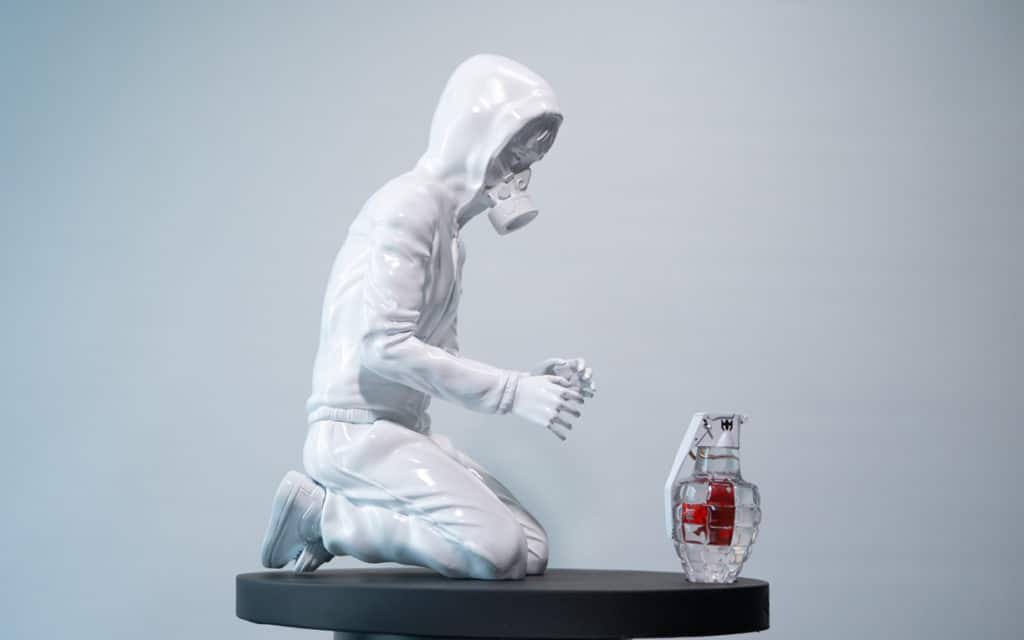
The film kind of came after that, because Dan had a client he sold a painting to who was actually a filmmaker, and he said, ‘Oh, you know if you’ve got any projects you’re working on, I’ll make a short film for you.’ And Dan said, ‘Oh, I’m actually working on a project with Maxim at the moment,’ so he told him the idea of the concept of the sculpture, and he made the film idea around that. We made a few adjustments to the film, but it’s more of the director’s idea. We kind of built the whole idea around the end concept of the boy, getting the box and then sitting down and then opening it. And then once we started to film, and we were actually in the second lockdown here, and it was snowing, it just happened to be snowing that day. It was just really weird. It was the only day it was snowing.
And as we were filming it, it felt like we were touching on so many different subjects we never even thought about. We were just thinking about making a sculpture, making a film for the sculpture, and that was it. But we were touching on children’s mental health and also homelessness. Because these two areas seem to be forgotten during the pandemic. Obviously, they talk about hospitalization, people going through certain things and certain treatments, and so on, but young kids and their mental health is an issue that was overlooked. Nobody was talking about that, or homelessness. So once we saw the film, it was like, ‘This touches on so many different subjects and so many different levels, so it’s not just a sculpture.’
It was a multi-level project that touched on so many different areas in our lives and everybody’s lives, which we didn’t realize. And so, once we launched it, we realized that it was more important to get charities on board, so we could donate sculptures to these charities. We’ve got NHS Charities Together on board, and we donated a sculpture to them. And a homeless charity as well called Shelter and a young mental health charity called YoungMinds. We donated sculptures to raise money for those charities. So it wasn’t just so simple. It kind of encapsulated the whole pandemic in a sculpture, and people could see the aftereffects and the effects going on through the film.
The whole idea behind the film is the box said vaccine on it, but it wasn’t like the vaccine you get in your arm, the vaccine was a grenade with a heart in it. It was about spreading love. Because we were going through a time that is so divisive. Everything in this time, I see it, and probably a lot of people could see. But some people have got the blinders on, and they don’t want to see it, but we’ve just got separation in everything in life. There are people over there, it’s anti-vax then there’s vax, and there’s Palestine and there’s Israel, and there’s Labor, there’s Conservative, there’s Brexit, no Brexit, Black Lives Matter, ‘we don’t like Black Lives Matter,’ and there’s all these different … it’s always like this side and that side fighting each other. And the grenade is just about obliterating all that and spreading love.
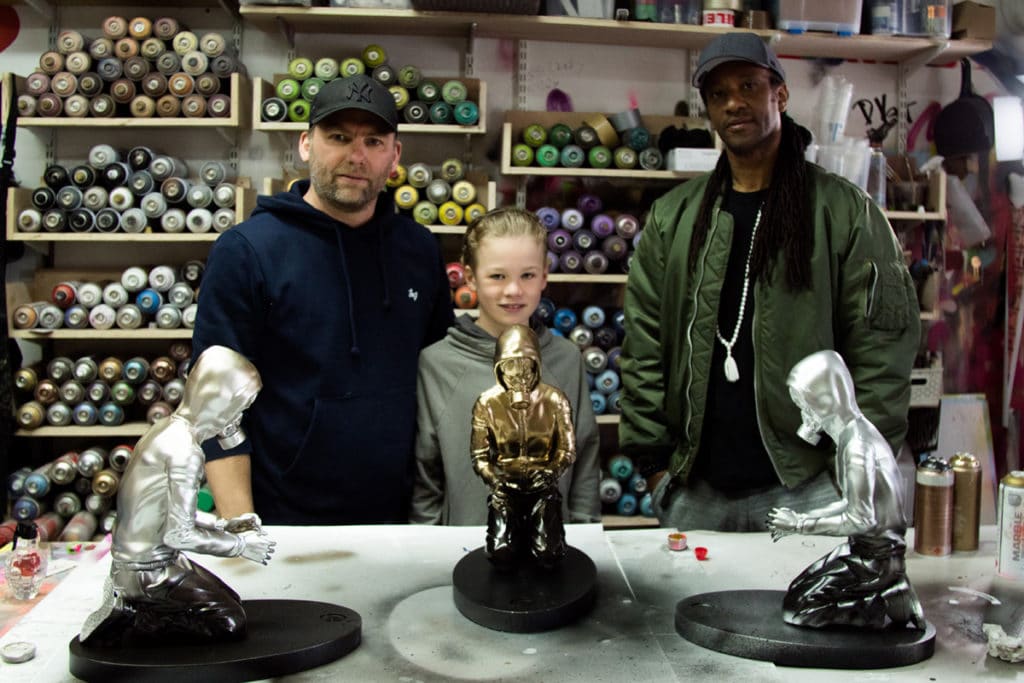
Did you have a timeframe in mind as to when you wanted to complete the overall project?
We actually started it before the second lockdown. It was around August time, and there wasn’t really a timeline as such. It happened quite organically, and it wasn’t something like, ‘Oh, we gotta push on with this.’ Dan was sending the ideas. I said, ‘Ah yeah, that’s cool. But how about if we change that and do that?’ and I’ll send it back to him. And then we kind of looked over things like that. And it just happened. I’m a true believer in not rushing things generally. I believe in just letting time do its thing.
Could you talk about your approach to the film score?
Obviously, there’s no voice in there. So the music has to do all the speaking, so to speak, the sound. It was my first venture into doing a score for a film. I’d write with a friend in my studio. It was a challenge, but I like challenges. When we made the film, obviously there wasn’t any score to it. We kind of put a score to it of another film, so we could get an idea.
So after we stripped that off, we lived with it for quite a few weeks and slowly started to build scene after scene. I didn’t do it as one piece. I had to break it down into scenes and then score that scene, score that scene, score that scene and what that felt and what that meant to me, and then slowly build it and piece it together. And then we did that and it got to a stage where I threw all that away because I thought, ‘No, it’s not hard enough. It doesn’t sound right. It’s too much piano. It’s not sound, it’s not enough soundscape in there.’ So I threw that away, and I did something which was kind of a bit more soundscape and a bit more strings and I put more sound design in.
And then I realized that it was a bit too dark and a bit too horror film. So I threw that away. Then I kind of merged the two together, and it sounded right; just the right amount of piano and the right amount of sound design elements over the top. It took me about a month of experimenting back and forth, just trying to get it right. And I’d leave it for a few days. Sometimes you can immerse yourself into it too much, and then I’d have to walk away from it and then do some painting or something else and then come back to it and do it for another two days, three days. It was interesting. I loved it.
So did the EP evolve out of the score?
Yeah, the EP evolved out of that. I did a few tracks around that when it was a bit more of a piano-style soundtrack, but then I didn’t think it sounded right. I felt it had to be a bit more filmic and a bit more instrumental and a bit more of a journey. So something that you can put on, you could turn the lights off, and you can just listen to it as a musical piece. It wasn’t something you turn on, and start singing to it and get lost in that way. I wanted it to be something where you actually put the music on, you can dim the lights down and, if you’ve got a good music system, you can just listen, you can turn it down, turn it to a certain level and you can just absorb yourself into the music. That was the whole idea behind that, really.
The EP is coming out through online distribution but is initially only available as a memory card included with the sculptures. What was the motivation behind that?
All my art, the pieces all come in a case. They all come in a metal flight case. Because this is the thing with me with art … it’s kind of like, I’ve seen it. I’ve been to a gallery, and there’s a sculpture on the side. And someone says, ‘Oh, I really like that sculpture. How much is that?’ And they say, ‘Oh, £15,000 .’ ‘Well, yeah, I’ll take it.’ Okay. I take it off the podium, wrap it in bubble wrap, a bit of Sellotape. There you go. And to me, that’s not presentation, when you’re spending £15,000. It’s the whole … when you in, and you see a sculpture or any kind of art you like, it’s a whole process of you seeing it visually being attractive to you. You want it. And obviously, you see the value of it. And you’re parting with your money, to buy this sculpture. So it’s a whole experience. So the experience of you looking at a sculpture and purchasing it, to the experience of someone who approaches you and says, ‘Hi, can I help you?’ It’s all part of the experience and how it’s presented and given to you and how you take it home and how you unwrap it. It’s all part of the experience of you putting it on the side of your cabinet, wherever, and what you get out of it. So when I do a sculpture, it comes in a flight case, and the Hope sculpture comes in a flight case. You get a pair of gloves and the memory card. I want it an immersive experience. So when you open it, you say, ‘Wow, okay, what’s in here? Some gloves. Okay. It’s a memory card.’ And it’s all written, the details, Hope sculpture by Maxim and Dan Pearce. And it’s got the track listings on the back. You put it in, you listen to the track, and you look at the sculpture, and you get the full pleasure of the whole experience. That’s what I’m about. It’s about the whole experience. So that’s how I do my sculptures.
Over the years, has it been a challenge at all balancing your visual art work and your musical career?
Not at all. I mean, obviously when I was touring, years ago, there’s less time to do things. Because once you’re touring and you come off tour, the last thing you want to do is do anything. You just want to relax. So I didn’t do much art, I didn’t do anything. But in the last couple of years, obviously, after the death of Keith, I needed something to focus on and art was my focus. I kind of immersed myself in art in a big way. Years ago I used to keep art and music separate because I always found that in the UK … and I don’t know if it’s the same in America, but in the UK when you’re an artist, you can only do one thing.
You know, ‘You’re a musician? You can’t be an artist as well. You’re not that talented. You can either be a musician or an artist, which one is it?’ So I always used to separate art and music. I was Maxim and I did art and that’s where the MM (Double M) came from, because I used to call myself MM and I used to keep it totally separate over there. And I never used to cross-pollinate the two, at all. But now I realize it’s just me, music, art. I’m a creative. I do music, art. I do anything which is creative, whether I’m making clothes, whether I’m making jewelry, whether I’m painting, whether I’m doing sculptures or whatever. It’s just art and it’s creating and it’s all coming from me. So I’m not afraid to say that it’s all come from the same place now; I’ve kind of accepted that.
And I voice that as well when I do interviews, I let people know that this is Maxim. It’s just Maxim art. I do use the MM logo. I find that in America, the press and the media are a bit more forgiving, I think. Because they kind of embrace people who are doing well. You kind of build them up. Whereas sometimes the media in the UK, when you get to a certain level and do things they want to knock you down.
For more info, visit:
www.MaximArt.co.uk
www.instagram.com/maxim/
rarible.com/maximart
twitter.com/maxim
instagram.com/Dan_Pearce_Art


